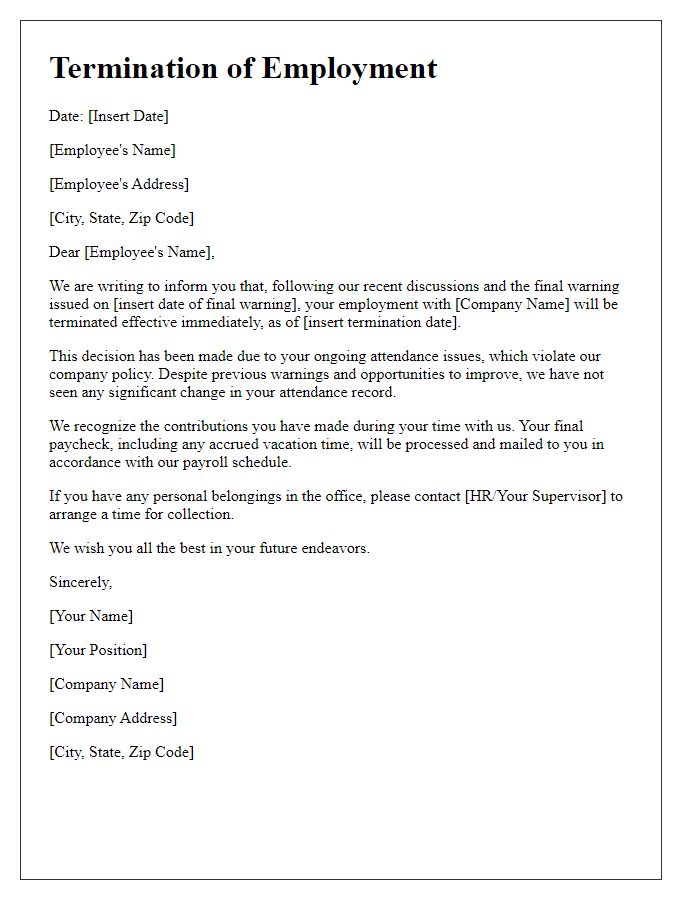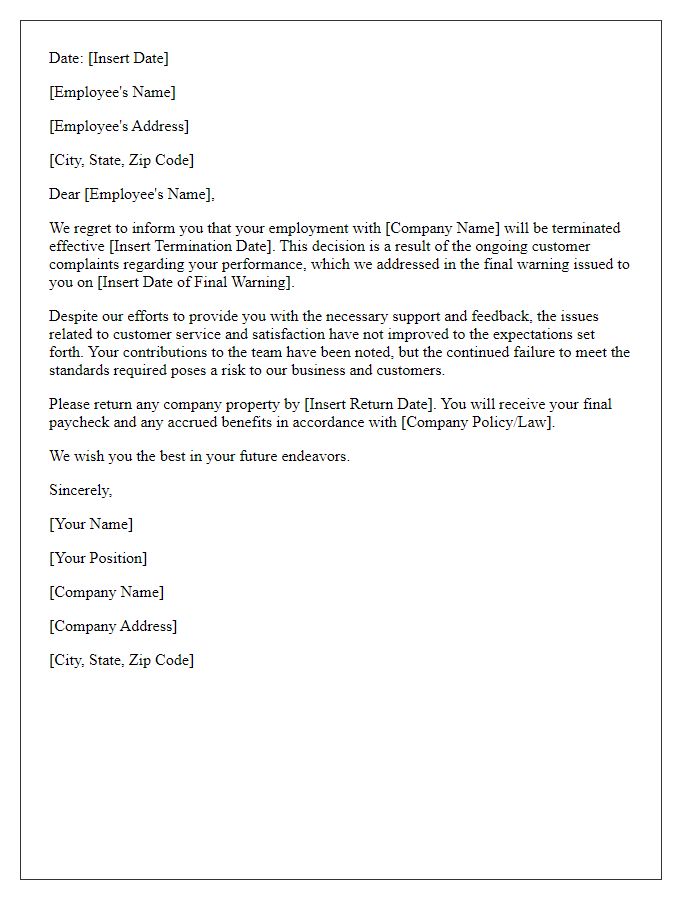Deciding to let an employee go is never an easy decision, but sometimes it becomes necessary for the well-being of the organization. When an individual has received a final warning, it signifies that there were opportunities to improve, yet the expected changes did not occur. In this article, we'll explore how to craft a professional and compassionate termination letter that reflects the company's values while addressing the situation appropriately. Join us as we navigate this sensitive topic and provide you with practical tips for handling the termination process smoothly.

Employee's Full Name and Address
Termination of employment often occurs after a series of warnings concerning performance or behavior issues. This process may involve several critical steps, including the delivery of a final warning. An example situation may involve an employee, Jane Doe, residing at 123 Main Street, Cityville, whose work performance has been reviewed multiple times over a six-month period, with three formal warnings issued. Each warning outlined specific areas needing improvement, such as punctuality and task completion, but no significant changes were observed. Consequently, the decision to terminate employment is based on company policy and ethical considerations, ensuring that proper documentation and rationale are provided. The termination letter should reference the final warning date, which might have been issued on September 10, 2023, and include details regarding the termination date, severance information, and procedures for returning company property.
Date of Letter Issuance
Termination of employment often follows a series of disciplinary actions, including a final warning issued by an employer. The date of letter issuance plays a critical role in ensuring proper documentation and compliance with company policies. Termination letters typically outline the reasons for dismissal, such as violation of company standards, poor performance, or misconduct. For example, a company may reference the employee's previous infractions (e.g., repeated tardiness or failure to meet deadlines) documented in the employee file. Properly dated letters lead to clearer communication and provide a timeline that protects both the employer and employee in the event of disputes. In many jurisdictions, this written record is essential for legal compliance and proof of due process in employment termination.
Reference to Previous Warnings and Incidents
Termination of employment can occur after a series of documented warnings, such as verbal or written warnings, which have previously addressed performance issues or misconduct. This process often follows a final warning, providing the employee with an opportunity to improve behavior or work output. Incidents leading to termination might include missed deadlines, violation of company policy, or lack of professionalism, detailed in prior communications. These occurrences are crucial in establishing a pattern of behavior that demonstrates a failure to meet the employer's expectations. Documentation, including dates and specifics of each warning, plays a significant role in justifying the termination decision, ensuring fairness and compliance with labor laws.
Clear Statement of Termination
Termination of employment often follows a process that includes multiple warnings. A final warning typically signals a last opportunity for the employee to rectify their performance or behavior. Failure to improve may lead to termination. Clear communication is essential during this process to uphold professionalism and ensure compliance with employment laws. An official termination letter specifies the intent to end employment relationships. It usually includes the employee's name, position, and employment period. The letter might reference the final warning date, the specific infractions or performance issues that prompted the termination, and any steps taken by the employer to assist the employee prior to this decision. Notices about final paycheck distribution, benefits termination, and return of company property are commonly included as well. Maintaining concise, respectful language throughout the letter is critical to preserving professionalism and reducing potential legal repercussions. Record retention may also be advised for documentation purposes.
Final Details: Health Benefits, Final Pay, Returning Company Property
Termination of employment following a final warning can involve several critical aspects. Health benefits, which may include medical, dental, and vision coverage, typically cease either immediately or at the end of the month after termination, depending on the company policy. Final pay, including any earned but unused vacation days and overtime, must be calculated and issued in compliance with local labor laws, often within a specified timeframe such as 72 hours post-termination. Returning company property entails physically returning items such as electronic devices, keys, uniforms, and identification badges to the human resources department, often scheduled for a specific date to ensure proper processing and documentation of the return.
Letter Template For Termination Following Final Warning Samples
Letter template of termination after final warning for performance issues

Letter template of termination following final warning regarding attendance

Letter template of termination after final warning for policy violations

Letter template of termination after final warning for unsatisfactory productivity

Letter template of termination following final warning on behavioral concerns

Letter template of termination after final warning for not meeting deadlines








Comments